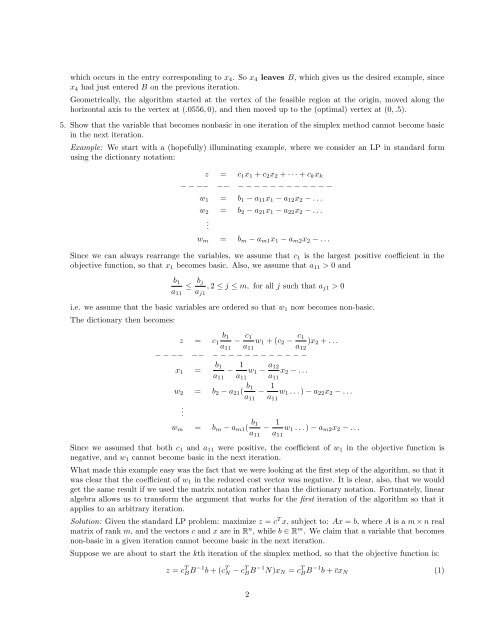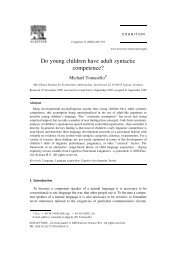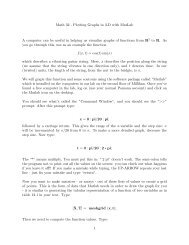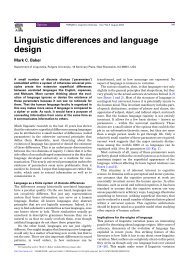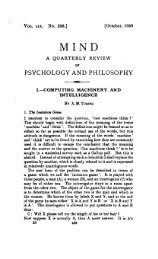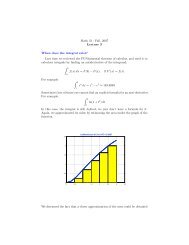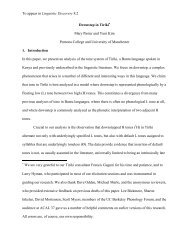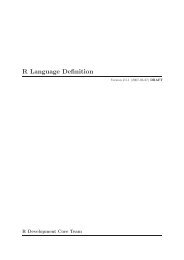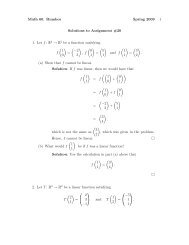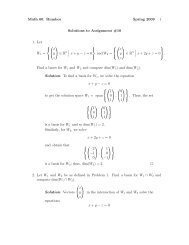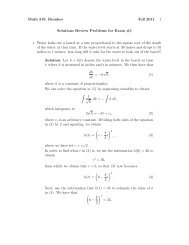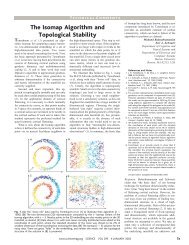Math 187 Solutions to Homework 2: Part 2 Radunskaya 4. Give an ...
Math 187 Solutions to Homework 2: Part 2 Radunskaya 4. Give an ...
Math 187 Solutions to Homework 2: Part 2 Radunskaya 4. Give an ...
Create successful ePaper yourself
Turn your PDF publications into a flip-book with our unique Google optimized e-Paper software.
which occurs in the entry corresponding <strong>to</strong> x 4 . So x 4 leaves B, which gives us the desired example, sincex 4 had just entered B on the previous iteration.Geometrically, the algorithm started at the vertex of the feasible region at the origin, moved along thehorizontal axis <strong>to</strong> the vertex at (.0556, 0), <strong>an</strong>d then moved up <strong>to</strong> the (optimal) vertex at (0, .5).5. Show that the variable that becomes nonbasic in one iteration of the simplex method c<strong>an</strong>not become basicin the next iteration.Example: We start with a (hopefully) illuminating example, where we consider <strong>an</strong> LP in st<strong>an</strong>dard formusing the dictionary notation:z = c 1 x 1 + c 2 x 2 + · · · + c k x k− − −− −− − − − − − − − − − − − −w 1 = b 1 − a 11 x 1 − a 12 x 2 − . . .w 2 = b 2 − a 21 x 1 − a 22 x 2 − . . ..w m = b m − a m1 x 1 − a m2 x 2 − . . .Since we c<strong>an</strong> always rearr<strong>an</strong>ge the variables, we assume that c 1 is the largest positive coefficient in theobjective function, so that x 1 becomes basic. Also, we assume that a 11 > 0 <strong>an</strong>db 1a 11≤ b ja j1, 2 ≤ j ≤ m, for all j such that a j1 > 0i.e. we assume that the basic variables are ordered so that w 1 now becomes non-basic.The dictionary then becomes:z =b 1c 1 − c 1w 1 + (c 2 − c 1)x 2 + . . .a 11 a 11 a 12− − −− −− − − − − − − − − − − − −x 1 =b 1− 1 w 1 − a 12x 2 − . . .a 11 a 11 a 11w 2 = b 2 − a 21 ( b 1a 11− 1a 11w 1 . . . ) − a 22 x 2 − . . ..w m = b m − a m1 ( b 1a 11− 1a 11w 1 . . . ) − a m2 x 2 − . . .Since we assumed that both c 1 <strong>an</strong>d a 11 were positive, the coefficient of w 1 in the objective function isnegative, <strong>an</strong>d w 1 c<strong>an</strong>not become basic in the next iteration.What made this example easy was the fact that we were looking at the first step of the algorithm, so that itwas clear that the coefficient of w 1 in the reduced cost vec<strong>to</strong>r was negative. It is clear, also, that we wouldget the same result if we used the matrix notation rather th<strong>an</strong> the dictionary notation. Fortunately, linearalgebra allows us <strong>to</strong> tr<strong>an</strong>sform the argument that works for the first iteration of the algorithm so that itapplies <strong>to</strong> <strong>an</strong> arbitrary iteration.Solution: <strong>Give</strong>n the st<strong>an</strong>dard LP problem: maximize z = c T x, subject <strong>to</strong>: Ax = b, where A is a m × n realmatrix of r<strong>an</strong>k m, <strong>an</strong>d the vec<strong>to</strong>rs c <strong>an</strong>d x are in R n , while b ∈ R m . We claim that a variable that becomesnon-basic in a given iteration c<strong>an</strong>not become basic in the next iteration.Suppose we are about <strong>to</strong> start the kth iteration of the simplex method, so that the objective function is:z = c T BB −1 b + (c T N − c T BB −1 N)x N = c T BB −1 b + ¯cx N (1)2


